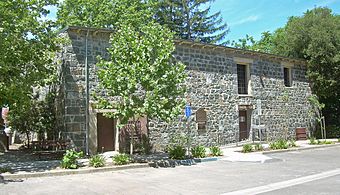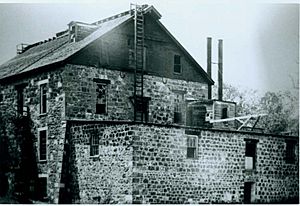Forbes Mill facts for kids
Quick facts for kids |
|
|
Forbes Mill Annex
|
|
 |
|
| Location | Los Gatos, California |
|---|---|
| Built | 1880 |
| Architect | James Alexander Forbes |
| NRHP reference No. | 78000776 |
| Added to NRHP | July 31, 1978 |
Forbes Mill is an old flour mill located in Los Gatos, California. It was first built in 1854. For many years, it served as the History Museum of Los Gatos.
The museum closed in 2014. Its collections are now part of the New Museum Los Gatos. The city of Los Gatos currently owns the building. This mill was the very first business building in Los Gatos. The two-story building you see today is actually a storage part, added in 1880. The original mill was a much taller, four-story stone building.
Contents
Building Forbes Mill
Forbes Mill was originally called the Santa Rosa Flour Mill. It was built by a man named James Alexander Forbes. He was born in Scotland in 1805 and moved to California around 1831.
Why Build a Mill?
During the California Gold Rush, James Forbes had a great idea. There were no flour mills in California at the time. Flour was very expensive, costing about $50 for one barrel!
Forbes decided to build a mill to make flour. He found a good spot on Los Gatos Creek. He thought this spot would have enough water to power a mill.
Getting Started
In 1850, Forbes bought about 2,000 acres (8.1 km2) of land near the creek. He started planning his mill. In 1853, he borrowed a lot of money, $130,000, to build it.
The mill was finished in 1854. However, the special milling machines had to travel all the way from New York. They came by ship around Cape Horn, which is at the very tip of South America.
Mill Opening Day
Once the machines arrived, Forbes had some trouble setting them up. But finally, the mill started grinding flour on December 1, 1855. This was an important moment for the Santa Clara Valley.
The mill was built on land that used to be a Mexican ranch. It showed how land ownership was changing. It moved from the original Californio families to new settlers. This happened after the Mexican–American War.
The first three floors of the mill were made of stone. This stone came from the Los Gatos Canyon. The top floor was made of wood. This wood came from trees in the mountains above Los Gatos. In 1880, a storage building was added to the mill. The town that grew around this mill was first called Forbes Mill, then Forbestown, and finally Los Gatos.
Challenges and Changes
Sadly, James Forbes didn't know much about how flour mills worked. He built a dam about 0.5 miles (0.8 km) upstream on the creek. Water flowed from the dam through a flume to two large 20-foot (6.1 m) high water wheels.
Water Problems
A 20-foot (6.1 m) water drop wasn't very efficient. Forbes had to keep raising the water level. Also, there was only enough water in the creek to power the mill during the winter months. This meant the machines sat idle for much of the year.
By the time the mill was running, other mills had been built. The Gold Rush was also ending. This caused flour prices to drop a lot, to only $5 per barrel.
Financial Troubles
Forbes had borrowed a lot of money. He also lost money buying and selling wheat and flour. Because of this, he went into bankruptcy. He couldn't pay back his loans.
In 1857, the mill and land were sold to Gustave Touchard. He was one of the people Forbes owed money to. Forbes continued to run the mill for Touchard for a short time. But he was eventually asked to leave the property in 1858.
Touchard hired other people to run the mill. But they didn't have much success either. Touchard did manage to sell parts of the land for a small profit.
A New Owner and Success
In 1866, William H. Rogers bought the mill. He had experience working at a flour mill in Detroit. He had also owned his own mill in Placerville.
Rogers had also been a postmaster and a sheriff. When he bought the mill, he renamed it "Clifton Mill."
Mill Improvements
Rogers's first step was to make big improvements. He raised the water flow to 65 feet (19.8 m). He replaced the old water wheels with new turbine wheels. He also upgraded the milling machines.
With his experience, Rogers was able to make the mill successful and profitable.
Growing the Business
In 1869, Rogers brought in two partners, WS McMurtry and JW McMillen. They renamed the company the Los Gatos Manufacturing Co. They increased the water flow even more, to 200 feet (61.0 m).
They also built reservoirs to store enough water. This allowed the mill to produce flour all year long. With these improvements, the mill could make 100 barrels of flour every day!
In 1881, the Los Gatos News newspaper praised the mill. It said that for making the best flour in the world, "Los Gatos Flouring Mills stands preeminent."
Later Years of the Mill
Forbes Mill continued to make flour until 1887. After that, it was used for many different things. It became a power plant for the Los Gatos Ice and Power Company. Then it was a brewing and bottling company.
Later, it became the Los Gatos Gas Company. Finally, it was a substation for PG&E. The original "Santa Rosa" Flour Mill building was torn down in 1916.
The remaining building was used as a storehouse for PG&E until after World War II. Then it was left empty for a while. In 1971, it was brought back to life as a youth center for Los Gatos. It even had live rock music on Friday and Saturday nights!
On June 10, 1950, the California Centennial Commission honored the mill. They recognized its important role in California's history. It was named California Historical Landmark number 458. It is also listed on the National Register of Historic Places.
![]() This article incorporates public domain material from websites or documents of the National Park Service.
This article incorporates public domain material from websites or documents of the National Park Service.



